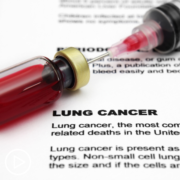How Can Biomarkers Help With Lung Cancer Treatment?
How Can Biomarkers Help With Lung Cancer Treatment? from Patient Empowerment Network on Vimeo.
Biomarkers can assist with lung cancer treatment, but how are they used exactly? Expert Dr. Christian Rolfo from Mount Sinai explains what is examined in biomarkers and how they aid treatment of specific population groups.
See More from Best Lung Cancer Care
Related Resource:

|

|

|
Transcript:
Dr. Nicole Rochester:
We know that no two lung cancers are the same. Can you explain to the audience how biomarkers help with lung cancer treatment and they can be so important?
Dr. Christian Rolfo:
Yeah, we have different…as I say, we are looking at specific characteristics from the tumor when I’m referring to genomic alterations that I’m not referring to something that you can get from your family and bring to your descendants. So I’m talking about mutations that are occurring inside the tumors and only for the tumor, and so affecting only the subject that has this patient that has this alteration. So these biomarkers are an important way to identify populations that we can treat specifically, and I would like to be a little bit more specific on that. We have some of the alterations, for example, one of the mutations that we call EGFR or epidermal growth factor receptor mutation that is supported in different populations in different frequencies. For example, if we have patients that are with an Asiatic origin, we have there the possibility to have a…and I’m referring, for example, Chinese, Japanese, this area of the East Asia, we have a hyper-prevalence of these mutations in around 50 percent of the patients with lung cancer, non-squamous we’d say this is another characteristic of the tumor can have this specific alteration. If we are moving, for example to Latinos, the pains of the areas of Latinos they are coming from, if you have Mexican or, for example, Peruvian, they have also due to their ancestry, they are similar to the Asiatic population, 40 percent we’re going to white populations and Anglo-Saxons or Europeans, they have around 7 to 15 percent according to the different regions.
African Americans within 15 to 20 percent. So these kinds of alterations are giving us the opportunity to treat and we have nowadays inhibitors and that’s drugs that are from first, second and third generation, so we were evolving in January, this pharmaceutical in January to develop all drugs that are able to penetrate in the brain and acting not only in the tumor, but also in brain metastases. And patients who have this mutation, for example, are treated in first line, in front line, or the first treatment that they receive are pills, no chemotherapy. So for this reason, and that is something that is important because when we know that patients, when they start this journey of lung cancer diagnosis before they see an oncologist, they were struggling to get the diagnosis and then we’re passing through several doctors from the general practitioner or to the emergency room, going to CT scan and then a biopsy then a pulmonologist until they get the diagnosis, it’s a big period of time sometimes that we are very nervous because we want to each patient to have a treatment as soon as possible, and sometimes when they arrive to us, we say they need to wait until we have the results of these biomarkers.
So it’s difficult to understand, I put in the place of the patients and the families are really difficult to understand that I was passing a lot, I went here, I came here and I want your treatment right away, but this period that we are asking to wait is really important, because we will have information that can change radically the treatment and the history of these patients. So one of the problems that we have in America is the lack of testing, so we have all the tools to test the patients, but if we are looking at some of the statistics, 50 percent of the patients have been tested. 39 percent if we are moving to groups, for example, of AfricanAmericans, so we need to be very careful that don’t push to get the treatment very quickly without having all the elements to this thing, which kind of treatment is the most adequate for the patient.
Dr. Nicole Rochester:
That is such important information, and I really appreciate that, I appreciate it. That you put it in the perspective of the patients and family members. And that grueling, long wait, long time to diagnose this, and finally you’re in front of a specialist and the perception is that, Okay, now I’m going to get this treatment that I need, and then like you said to hear, now you have to wait a little bit longer, but also to understand that that wait is important to make sure that you get the treatment that is meant for your specific type of cancer, I think that is so incredibly important.
Dr. Christian Rolfo:
And believe me, we are trying to push as well from the that there are, unfortunately, technical times that we cannot overcome that are for testing and for having these results, and we can do that by like I said liquid biopsy, but also tissue biopsy, so we are sending the tissue that the patients gave for a biopsy in a biopsy or in a resection when they have surgery. We take these small biopsies and we send them for analysis and take longer sometimes, so it’s a pity and we know, but it’s the only way to go for the right treatment.



